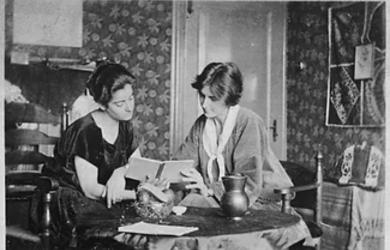 Freida Belifante was born in Amsterdam in 1904, and showed musical talent from an early age. By age 17 she was a professional cellist, and in 1937, at age 33, she was appointed the conductor of Concertgebouw. This made her the first woman in the world to lead an orchestra.
Freida Belifante was born in Amsterdam in 1904, and showed musical talent from an early age. By age 17 she was a professional cellist, and in 1937, at age 33, she was appointed the conductor of Concertgebouw. This made her the first woman in the world to lead an orchestra.
Belifante married in 1931, but divorced a short time later when she came out to her husband. After the divorce, she had relationships exclusively with women. Her longest relationship before the war was with composer Henriëtte Bosmans.
Her career in music was cut short when the Nazis conquered the Netherlands. Belifante, whose status as a famous musician gave her some protection, chose not to flee her home to safety. Instead she joined the Dutch resistance, alongside Willem Arondeus, who was also openly homosexual. They were tasked with forging documents to smuggle Jews out of the Netherlands.
In 1943, the Nazis’ began to suspect that documentation was forged, and their job became more difficult. Belifante came up with an ingenious plan to prevent Nazis from discovering which documents were forged – blow up the headquarters for the Nazi population registry in Amsterdam.
The operation was planned by Belifante, but she was not allowed to join the executive team due to her sex. The operation was a partial success, and the explosion led to the destruction of 800,000 Jewish ID cards – around 15% of the records kept in the chosen building. Following the operation, the squad members were found and captured by Nazis. Arondeus’ diary was found, and he was executed in early July 1943. His last words were: “Tell the people that homosexuals are not by definition weak!” He was posthumously recognised by Yad Vashem as Righteous Among the Nations.
Following Arondeus’ capture, Belifante went underground. She cut her hair short, and lived for three months under the false identity of a man. She was so convincing that even her mother did not recognise her when she passed her on the street. She fled to Switzerland, took refuge in a Swiss refugee camp. There she remained until the end of the war, giving free cello lessons to the residents.
When the war ended, she returned to Amsterdam to discover that most of her friends had died. Her tremendous contribution to the Dutch resistance slowly came to light, and 15 years after she was voted out of the orchestra, Orange County established a day of memorial in her name. Additionally, she has been recognised by both the American Holocaust Museum and the Dutch government. In 1995, she passed away at age 91.
Milena Jesenska & Margarete Buber-Neumann